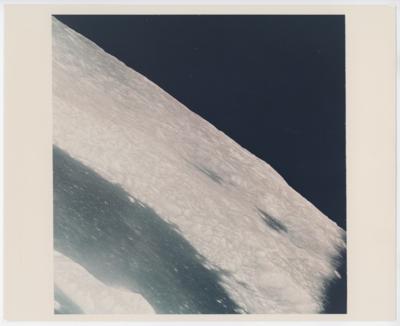Frank Borman (Apollo 8)
Crater Tsiolkovsky, the most striking feature of the backside of the Moon, as first seen by humans, 21-27 December 1968
Vintage chromogenic print on fiber-based paper, printed 1968, (NASA AS8-14-2447), with"A KODAK PAPER" watermark on verso, (NASA/North American Rockwell), 20,3 x 25,4 cm
The backside of the Moon often called the “Dark Side” of the Moon refers to the hemisphere of the Moon that is facing away from the Earth, first seen with their own eyes by the crew of Apollo 8.
In reality it is no darker than any other part of the Moon’s surface as sunlight does in fact fall equally on all sides of the Moon. It is only “dark” to us, as that hemisphere can never be viewed from Earth due to a phenomenon known as “Tidal Locking”. A better term for the side we don’t see is the “farside’” or “backside” rather than the “dark side”.
Borman took this very rare photograph on orbit 8 with the 250mm telephoto lens as he enjoyed a lonely view of the spectacular backside of the Moon during Lovell and Anders’ sleep period. This sublime oblique view is looking southeast into the heart of Crater Tsiolkovsky, showing its well-defined central peak, dark mare floor and southeast rim.
Tsiolkovsky is a large, 200-km crater on the far Moon’s side which was first photographed by the Soviet probe Luna 3 on 7 October 1959. In the poor imagery of the time, its dark, mare-like interior made it stand out from the other craters that pepper the farside. The triumphant Soviets, in the manner of all explorers, promptly and appropriately named it after the Polish-Russian pioneer of spaceflight theory, Konstantin Tsiolkovsky (1857-1935). A dominant, W-shaped central peak of light colored highland material rising out of the dark material makes this crater particularly distinctive and striking. (from the Apollo 15 Flight Journal at 083:16:51)
“We were like three school kids. The most awe-inspiring sight. Looking back at the back side of the Moon [...] for the very first time.”
Expertin: Mag. Eva Königseder
 Mag. Eva Königseder
Mag. Eva Königseder
+43-1-515 60-421
eva.koenigseder@dorotheum.at
27.09.2023 - 15:06
- Erzielter Preis: **
-
EUR 338,-
- Schätzwert:
-
EUR 600,- bis EUR 800,-
- Startpreis:
-
EUR 100,-
Frank Borman (Apollo 8)
Crater Tsiolkovsky, the most striking feature of the backside of the Moon, as first seen by humans, 21-27 December 1968
Vintage chromogenic print on fiber-based paper, printed 1968, (NASA AS8-14-2447), with"A KODAK PAPER" watermark on verso, (NASA/North American Rockwell), 20,3 x 25,4 cm
The backside of the Moon often called the “Dark Side” of the Moon refers to the hemisphere of the Moon that is facing away from the Earth, first seen with their own eyes by the crew of Apollo 8.
In reality it is no darker than any other part of the Moon’s surface as sunlight does in fact fall equally on all sides of the Moon. It is only “dark” to us, as that hemisphere can never be viewed from Earth due to a phenomenon known as “Tidal Locking”. A better term for the side we don’t see is the “farside’” or “backside” rather than the “dark side”.
Borman took this very rare photograph on orbit 8 with the 250mm telephoto lens as he enjoyed a lonely view of the spectacular backside of the Moon during Lovell and Anders’ sleep period. This sublime oblique view is looking southeast into the heart of Crater Tsiolkovsky, showing its well-defined central peak, dark mare floor and southeast rim.
Tsiolkovsky is a large, 200-km crater on the far Moon’s side which was first photographed by the Soviet probe Luna 3 on 7 October 1959. In the poor imagery of the time, its dark, mare-like interior made it stand out from the other craters that pepper the farside. The triumphant Soviets, in the manner of all explorers, promptly and appropriately named it after the Polish-Russian pioneer of spaceflight theory, Konstantin Tsiolkovsky (1857-1935). A dominant, W-shaped central peak of light colored highland material rising out of the dark material makes this crater particularly distinctive and striking. (from the Apollo 15 Flight Journal at 083:16:51)
“We were like three school kids. The most awe-inspiring sight. Looking back at the back side of the Moon [...] for the very first time.”
Expertin: Mag. Eva Königseder
 Mag. Eva Königseder
Mag. Eva Königseder
+43-1-515 60-421
eva.koenigseder@dorotheum.at
|
Käufer Hotline
Mo.-Fr.: 10.00 - 17.00
kundendienst@dorotheum.at +43 1 515 60 200 |
| Auktion: | The Beauty of Space - Iconic Photographs of Early NASA Missions |
| Auktionstyp: | Online Auction |
| Datum: | 27.09.2023 - 15:06 |
| Auktionsort: | Wien | Palais Dorotheum |
| Besichtigung: | Online |
** Kaufpreis inkl. Käufergebühr und Mehrwertsteuer
Es können keine Kaufaufträge über Internet mehr abgegeben werden. Die Auktion befindet sich in Vorbereitung bzw. wurde bereits durchgeführt.

